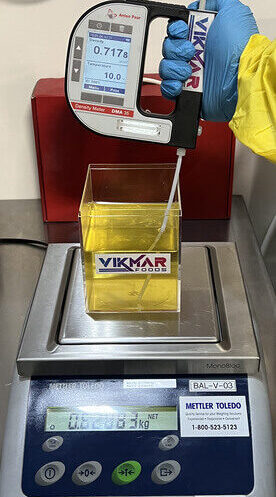
Mississauga, ON – April 19, 2024 — Canola oil’s density undergoes meticulous laboratory testing across a spectrum of temperatures, offering valuable insights into its behavior under varying conditions. Through rigorous experimentation, data reveals a consistent trend: as temperature rises, the density of canola oil decreases. This empirical evidence underscores the importance of precise measurement and understanding of temperature-dependent changes in density for industries ranging from food production to scientific research. By providing verified data, this laboratory-tested information equips professionals with the knowledge needed to make informed decisions and optimize processes, ensuring reliable outcomes in their respective fields.
How Density of Canola Oil Changes With Temperature
The density of canola oil is known to exhibit a clear relationship with temperature. This phenomenon can be understood through the principles of molecular behavior and thermal expansion.
At lower temperatures, canola oil molecules are relatively closer together, resulting in a higher density. As the temperature increases, the kinetic energy of the molecules also increases. This increased kinetic energy causes the molecules to move more vigorously and with greater freedom, leading to an expansion in volume while maintaining a relatively constant mass. Consequently, the density of canola oil decreases as temperature rises.
The provided data supports this theory, demonstrating a consistent trend of decreasing density as temperature increases. As canola oil is subjected to higher temperatures, its density steadily decreases from 0.9279 g/cm³ at 5°C to 0.8965 g/cm³ at 50°C.
This temperature-dependent change in density has practical implications in various fields, particularly in cooking, manufacturing, and scientific research. Understanding how the density of canola oil varies with temperature allows for more accurate measurements, formulations, and predictions in these applications. Additionally, this knowledge enables the optimization of processes to achieve desired outcomes while accounting for changes in temperature.
Image Showing the Temperature and Density of Canola Oil

0 Degrees Celsius
Lowest temperature at which tests were performed, the canola oil exhibits the highest density of 0.9317 g/cm³. This indicates that the molecules are closely packed together due to the low temperature.
 5 Degrees Celsius
5 Degrees Celsius
At this temperature, the canola oil exhibits a relatively high density of 0.9279 g/cm³. This indicates that the molecules are closely packed together due to the low temperature.
 10 Degrees Celsius
10 Degrees Celsius
The density drops notably to 0.7178 g/cm³ compared to 5 degrees Celsius. This significant decrease suggests that as temperature increases, the molecules in the canola oil spread out more, reducing the overall density.

15 Degrees Celsius
The density slightly increases to 0.9224 g/cm³ compared to 10 degrees Celsius. This indicates that the canola oil is adapting gradually to the higher temperature, with molecules beginning to reorganize but still less dense than at 5 degrees Celsius.

20 Degrees Celsius
The density remains relatively stable at 0.9176 g/cm³ compared to 15 degrees Celsius. This stability suggests that the canola oil continues to adjust to the temperature increase, but the rate of expansion is slowing down.

25 Degrees Celsius
A slight decrease in density is observed compared to 20 degrees Celsius, with a density of 0.9141 g/cm³. This suggests that while the canola oil is still expanding with the temperature, the rate of expansion is minimal at this point.

30 Degrees Celsius
A more pronounced decrease in density is observed with a density of 0.9107 g/cm³ compared to 25 degrees Celsius. This indicates that as the temperature continues to rise, the molecules become more energetically agitated, spreading out further and decreasing the overall density.

35 Degrees Celsius
The density continues to decrease gradually, reaching 0.9061 g/cm³ at 35 degrees Celsius. This reflects the ongoing expansion of the canola oil molecules as the temperature increases.

40 Degrees Celsius
A further decrease in density is observed compared to 35 degrees Celsius, with a density of 0.9031 g/cm³. This indicates that the canola oil molecules experience even greater spacing due to the increased thermal energy.

45 Degrees Celsius
The density continues to decrease as expected, reaching 0.8989 g/cm³. This further reduction in density illustrates the continued expansion of molecules due to the higher temperature.

50 Degrees Celsius
At this temperature, the canola oil exhibits the lowest density among the recorded temperatures, with a density of 0.8965 g/cm³. This reflects maximum expansion of molecules due to the highest temperature in the series, aligning with the principle of thermal expansion.
In summary, these explanations demonstrate how the density of canola oil decreases consistently as temperature increases, illustrating the principle of thermal expansion.
Disclaimer Clause
The experimental data provided herein is for informational purposes only, even though the measurements were done using one of the most advanced devices, Vikmar Foods makes no representations or warranties of any kind, express or implied, about the completeness, accuracy, reliability, suitability, or availability of the experimental data. Any reliance you place on such information is strictly at your own risk.

